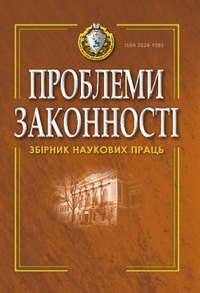Synchronic and diachronic comparisons as forms of comparative historical and legal analysis
DOI:
https://doi.org/10.21564/2414-990x.146.170512Keywords:
comparative historical and legal research, synchronic comparison, diachronic comparison, time, space, historical process, historical geographyAbstract
The modern level of historical and legal science development objectively causes rethinking of its traditional methodological approaches and ways of scientific knowledge of the historical past. Comparative historical and legal method that requires its adaptation to the new realities of the functioning of the science of the history of state and law is one of such methods.
The systematic application of the comparative historical and legal method when studying state legal phenomena of various levels provides for the sufficient elaboration of its logical and methodological foundations. Herewith, the most important issues are: the problem of selecting objects of historical and legal comparison, researching sources of comparative work, typologizing historical and legal phenomena, and the problem of choosing the forms in which the comparative analysis will be carried out.
Historical and legal objects being both at the same stage of their historical development and at the different stages in chronological significance can be the subject of historical and legal comparison. In the first case, it will be about the synchronic comparison, which allows to reveal the general and the especial between the objects being compared that exist during a certain period of time, in the other – about the diachronic one, which allows to consider historical and legal objects at different historical stages of their existence. As it can be seen, the category of time is the main criterion for distinguishing between these forms of comparison, since the principle of simultaneity is the basis of synchronic comparison, and the principle of time sequence is the basis of diachronic one.
Both synchronic and diachronic comparisons as forms of comparative historical and legal analysis have a rather complex structure. At the same time, the synchronic approach, being based on the simultaneity of historical and legal phenomena, provides for the statical character of the objects being compared, the determination of their geographical location, and the abstraction from their previous historical development. The diachronic approach, on the contrary, obliges a comparativist to take into account the dynamics of the genesis of historical and legal objects, allowing during the comparison both to establish different stages of their development and to reveal the specificity of the evolution of complex state legal systems. In general, the synchronic and diachronic approaches possess sufficiently broad cognitive capabilities, which make it possible to refer them to the main types of comparative procedures in comparative historical and legal research.
References
Bekhruz, Kh. (2009). Porivnialne pravoznavstvo. Odessa: Feniks [in Ukrainian].
Koval'chenko, I. D. (2003). Metody istoricheskogo issledovanija. Moscow: Nauka [in Russian].
Koseriu, Je. (1963). Sinhronija, diahronija i istorija. Novoe v lingvistike. Moscow: Izd-vo inostrannoj literatury, issue 3, 143–343 [in Russian].
Kosolapov, V.V. (1977). Metodologija i logika istoricheskogo issledovanija. Kyiv: Vishha shkola [in Russian].
Luts, L.A. (2006). Teoriia porivnialno-pravovoho metodu. Metody ta zasoby porivnialno-pravovoho doslidzhennia. Derzhava i pravo. Yurydychni i politychni nauky. Kyiv: In-t derzhavy i prava NAN Ukrainy, issue 31, 489–496 [in Ukrainian].
Podkorytov, G.A. (1968). Osobennosti primenenija sravnitel'no-istoricheskogo metoda v jazykoznanii. Metodologicheskie voprosy obshhestvennyh nauk. Leningrad: Izd-vo Leningr. un-ta, 263–279 [in Russian].
Rakitov, A.I. (1982). Istoricheskoe poznanie: sistemno-gnoseologicheskij podhod. Moscow: Politizdat [in Russian].
Serov, N.K. (1974). Processy i mera vremeni: problemy metodologii strukturno-diahronicheskogo issledovanija v sovremennoj nauke. Leningrad: Nauka, Leningradskoe otdelenie [in Russian].
Sossjur, F.de. (1933). Kurs obshhej lingvistiki. Moscow: SOCJeKGIZ [in Russian].
Fajziev, M.M. (1986). Sovetskoe sravnitel'noe pravovedenie v uslovijah federacii. Tashkent [in Russian].
Kharytonova, O.I., Kharytonov, Ye.O. (2002). Porivnialne pravo Yevropy: Osnovy porivnialnoho pravoznavstva. Yevropeiski tradytsii. Kharkiv: Odissei [in Ukrainian].
Cantos, P., Vázquez, N. (2011). A diachronic approach to scientific lexicon in English: Evidence from Late Modern English corpora. Revista de Lenguas para Fines Específicos, 17, 253–294.
Dam, L., Dam-Jensen, H. (2007). Diachronic and Synchronic Analysis – the Case of the Indirect Object in Spanish. Hermes – Journal of Language and Communication Studies, 38, 187–203.
Havlik, V. (2015). A unifying framework for synchronic and diachronic emergence. International Journal of Latest Research in Science and Technology, vol. 4, issue 2, 132–137.
Iacobini, C., Fagard, B. (2011). A diachronic approach to variation and change in the typology of motion event expression. A case study: From Latin to Romance. Cahiers de Faits de langue, 3, 151–172.
Ilyinova, E.Yu., Kochetova, L.A. (2016). Diachronic Perspective in Text and Discourse Studies. Science Journal of VolSU. Linguistics, vol. 15, 4, 18–25.
Robo, MSc. L. (2013). A Diachronic and Source Approach of Phraseological Units – Theories of Definition, Criteria and Structure Analysis in English and Albanian Language. Academic Journal of Interdisciplinary Studies. Italy: MCSER Publishing-Rome, vol. 2, 9, 589–596.
Tekavčić, P. (1972). Grammatica storica dell'italiano. Vol. 1–3. Bologna: Società editrice il Mulino.
Downloads
Published
How to Cite
Issue
Section
License
Copyright (c) 2019 Денис Анатолійович Шигаль

This work is licensed under a Creative Commons Attribution 4.0 International License.










